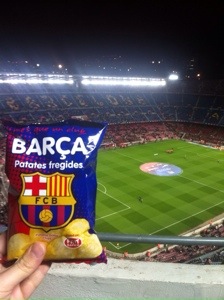When I awoke it was around 11:00 so I struggled out of my slumber. My missions for the day were to get acquainted with the lay of the land, collect my spectator pass, and hopefully buy some tickets to events on Wed and Thu (I already had tickets for Tue, Fri, and Sat.)
There’s a place to pick up your spectator pass in Adler about a 15 minute walk from my hotel. I walked down a block or two to the boardwalk and turned left. (Quick side-note which I forgot to add to my first post: The woman who helped me in the airport said “that’s so poetic” when I told her the name of the hotel. Mechta u Morya apparently means something like “Dream by the Sea.”)
Somewhere, probably on the internet, I heard someone describe having the Olympics in Sochi as like having them in Atlantic City. Maybe it was even me, but I doubt it. [Editor’s Note: I was the one who said that. Don’t try to steal my thunder, Ezra Fischer!] There’s definitely some truth to that but the boardwalk in Adler is a bit more decaying-industrial than it is decaying-casino. The walk was quite pleasant and before long I was passing nice restaurants with large outdoor patios featuring big screen TVs playing the Olympics. I resisted and walked on into an oddly deserted western-ish mall. By asking a dude dressed head to toe in Canadian gear (note — there seem to be way more Canadians than US citizens here or maybe they are just more obvious,) I found the spot and collected my spectator pass.
Here’s where the misadventure part of my day begins. I asked them where I could buy tickets — in the Adler train station, they replied. Okay — it looked like a 40 minute walk judging from google maps. I’ve been using google maps non-stop while I’ve been away because data is included in this nifty plan I got thanks to a colleague of mine. NOT IN RUSSIA! Ooops — glad I picked up on that *only* a $100 into it.
Lunch was a delicious plate of grilled lamb or pork kebab with potato, onion, two different kind of pickles, and some red sauce. MMMmmm! I ate this outdoors (sorry folks, it’s pretty warm here) and then walked to the train station.
The trains are all free, which is great, but also had the odd effect of making me somewhat careless about which one I got on. So… the fifteen minute trip in one direction became an hour and a half round trip to get back to Adler followed by the necessary fifteen minute trip. Ooops. At least on the way back, two girls who had been working since five in the morning as information guides took pity on me and gave me a small Russian chocolate.
To cut an extraordinarily long story long, I eventually found my way to the ticket office in the Olympic park, bought some tickets, got a thrill out of seeing the Olympic flame, and made it back to my hotel safely. The security around here seems reasonably tight but not in an anxious paramilitary kind of way. Everyone looks like they are happy to be the center of the world for a few weeks and I’ve been able to get by with pointing and grunting and making faces pretty well.
I’m exhausted but excited to see what Day 2 brings tomorrow. I’ll post the events I’m going to be attending in a separate post for your voyeuristic pleasure!
Thanks for following along, it makes me happy to be able to tell you all about this stuff,
Ezra



